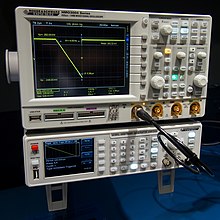Function generator
A function generator is a device for generating periodic electrical signals with different curve shapes, especially sine , square , triangle and sawtooth , with adjustable frequency (usually up to a few MHz) and amplitude .
Function generators are used to test electronic circuits such as amplifiers and filters .
Structure and properties
Depending on the equipment, there are setting options for symmetry, constant component and often also for wobble functions . Some devices contain a frequency counter for precise setting.
Analog function generators
Simple function generators with analog circuit technology contain an adjustable triangle oscillator whose output signal is converted into an approximate sinusoidal shape via a non-linear circuit. With these devices the sine outputs i. A. has a relatively high distortion factor . The square-wave signal is generated from the triangle by means of a comparator , whereby the pulse width of the square can be adjusted by changing the comparison voltage. This structure is available in the form of integrated circuits (e.g. XR2206, ICL8038, MAX038), which makes it very inexpensive to implement.
Digital function generators
Digital function generators, which are common today, work with direct digital synthesis (DDS) and can generate various periodic signal curves. The accuracy is much higher than for devices with analog circuit technology and depends primarily on the internal resolution in the DDS. As a rule, a crystal oscillator which clocks the DDS is used as the clock source . Using changeable memory tables, some of these devices can also be used to generate any programmable curve shapes and output them periodically. These function generators are called arbitrary generators .
functionality
The figure opposite shows a simple function generator using analog circuit technology. The operational amplifiers OP1 and OP2 generate the square and triangle signals as described under triangle generator . The resistors R5 to R6 and the diodes D1 to D6 form the sine shaper, a voltage-dependent resistor. If the triangle voltage increases, D1 and D2 first become conductive via R5. Then D3 and D4 will conduct through R6, and finally D5 and D6 will conduct as well. The higher the voltage at R4, the lower the resistance of the sine shaper circuit and the more the voltage divider R4 / sine shaper attenuates the signal. OP3 is connected as a buffer amplifier with gain = 1.



